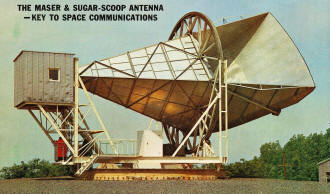Bell Telephone Labs' Sugar-Scoop Antenna
|
|
Being the birthday of Dr. Robert W. Wilson, there is no better occasion to post this article about the "sugar-scoop" antenna used by the two Bell Telephone Labs engineers (the other being Dr. Arno A. Penzias) who serendipitously discovered the cosmic microwave background radiation (CMBR) believed to be a signature of "The Big Bang." The pair were investigating an unexplained hiss in the background of the very low noise receiver attached to the antenna. That microwave energy was constant and came from all areas of the sky, regardless of where the antenna was pointed. They eventually deduced that the signature was consistent with the theoretical energy level of the primordial "soup" that was our universe a short time after expansion began. Although this piece was published in 1960, it was not until 1964 that the discovery was made. Articles here on RF Cafe which mention the Dr. Robert W. Wilson and Dr. Arno A. Penzias are The Maser & Sugar Scoop Antenna: Receiver for Signals from Space, Bell Telephone Laboratories Project Echo, The Amazing Maser: The Jewel That Conquers Space, Cosmic Radio Signals from Sun and Stars, and Sugar-Scoop Antenna. Sugar-Scoop Antenna
According to Frederick R. Kappel, President of American Telephone and Telegraph Co., the type of research that is being done by telephone scientists today in space communications is aimed at creating thousands of high-quality voice channels and, ultimately, television channels, that would interconnect all parts of the globe by way of satellites. The unusual shape of the antenna is required not only to obtain very high gain (about 43 db) and a narrow beam width (1 1/4°) but also to eliminate any side or rear lobes from the antenna's directional pattern. Even with large and highly directive parabolic-reflector antennas, some undesired lobes are directed toward the ground and the sky. These produce some noise in a system that cannot be tolerated because of the extremely weak signals. The entire structure, made largely from aluminum, is about 50 feet long and about 35 feet high. The horn opening measures around 20 by 20 feet. The entire assembly can be rotated through 360 degrees on its circular track, and the large upright wheel allows it to be oriented at any vertical angle. The output signals from the horn are applied through a rotary joint and some r.f. plumbing to the ruby maser amplifier located in the small cab at the end of the antenna. The maser maintains the high sensitivity and extremely low noise characteristics that are so essential in working with very weak signals. The maser employed is a two-channel device operating at a signal frequency of 2400 mc. The two channels are useful in picking up signals having either clockwise or counterclockwise circular polarization. The heart of the maser, a slab of ruby crystal, is kept at a temperature just a few degrees above absolute zero (-460°F), by being submerged in a container of liquid helium. This, in turn, is submerged in liquid nitrogen to prevent heat losses. The two tanks of helium and nitrogen are located underneath the cabin that houses the maser. Together with the horn-reflector antenna and an FM demodulation system, the maser makes the system the most sensitive voice radio receiver yet built. (Cover photo by Bell Telephone Labs.)
Posted January 10, 2018 |
|

